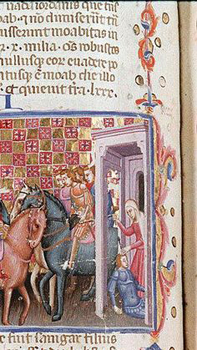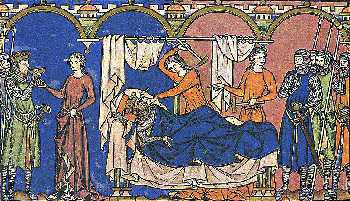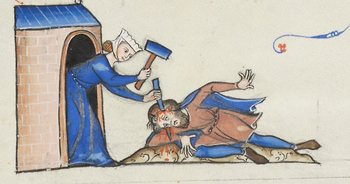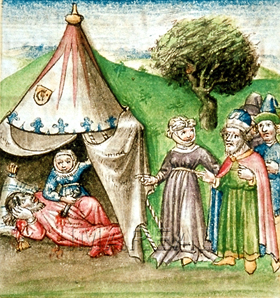From Our Archives
Debie Thomas, The Good Kind of Worthless (2020); Ed Rommen, Reflections on Last Things (2017); and Dan Clendenin, The "Deep History" of Extinction Events (2011).
For Sunday November 19, 2023
Lectionary Readings (Revised Common Lectionary, Year A)
Judges 4:1–7 or Zephaniah 1:7, 12–18
Psalm 123 or Psalm 90:1–12
1 Thessalonians 5:1–11
Matthew 25:14–30
This Week's Essay
Right when we need the solace of Scripture amidst the Middle East violence, the lectionary for this week includes one of the most barbaric stories in the entire Bible. It's a painful reminder that some of the violence in our world today is rooted in the violent texts of our religious traditions. Slaughtering your enemies and then celebrating it in poetry seems to have divine sanction.
In Judges 4 a housewife named Jael defeats a king named Jabin by pounding a tent peg through the temple of his commander Sisera. The story concludes in Judges 5 with a war poem called "The Song of Deborah" that taunts Sisera's mother and celebrates Jael's violence: "Most blessed of women be Jael. / She struck Sisera, she crushed his head, / she shattered and pierced his temple."
Or consider this example. In Israel's wars against the five Amorite kings, Joshua "left no survivors. He totally destroyed all who breathed." (Joshua 10:40). The next chapter describes the "huge army" of the northern kings. Joshua "totally destroyed them… not sparing anything that breathed." (11:11 and 14). Finally, we read how Joshua conquered "all these lands," and how God himself handed them over to him, "that he might destroy them totally, exterminating them without mercy." (11:20).
It's tempting to ignore passages like these, or to explain them away, but sacred violence isn't so easily expunged from our Scriptures. To help me think about Judges 4, this week I read the book by Eric Seibert called The Violence of Scripture (2012). He identifies seven types of violence in the Bible: justification of war, legitimation of colonialism, support for slavery, violence against women, harming children, the condemnation of gays, and, perhaps most importantly, the distortion of the character of God.
 |
|
From a Biblia Sacra. Codex Vindobonensis Palatinus 1191.
|
It's unfortunately easy to recall further examples of violence in the Bible. A few pages after Judges 4, there's the gang-rape, murder, and dismemberment of a nameless concubine (Judges 19). David beheaded Goliath, then "took the Philistine's head and brought it to Jerusalem" (1 Samuel 17). Deuteronomy 7:2 and 20:16–17 command the Israelites: "You must destroy them totally. Make no treaty with them, and show them no mercy… Do not leave alive anything that breathes — completely destroy them." The priest Phinehas was praised for his zeal when he slaughtered an Israelite and a Midianite woman with a single thrust of his spear (Numbers 25). Today the Eastern Orthodox churches celebrate Phinehas as a saint every year on September 2.
Some of the violence in Scripture is "merely" descriptive and not prescriptive, but much of it claims to be divinely sanctioned. From such divine approval, it's a short and tragic step to the human justification of religious violence like the crusades or the genocide against Indigenous Americans. Back in 1984, Phyllis Trible coined a phrase for the title of her book that has served as a proxy for violent verses like these — she called them "texts of terror." Today we could use the language of genocide, torture, abuse, crimes against humanity, or war crimes.
Down through the centuries readers have developed interpretive strategies to understand these disturbing texts. It's a complicated problem with a huge literature like the books by Siebert, Trible, and Philip Jenkins (Laying Down the Sword: Why We Can't Ignore the Bible's Violent Verses). What follows are ten of those strategies. Most of them contain elements of truth, and I find them partly helpful. But none of them is fully satisfying. At the end of the day, the texts of terror remain part of our sacred scriptures.
First, be honest, for ignorance is not bliss. Turning a blind eye to violent verses does not help. We ignore the texts of terror at our peril, because some Christians have used them to justify their own violence. We need to face up to them, even if they're embarrassing, and seem to have little relevance to our lives. We naturally gravitate toward passages like the Beatitudes, but we should not ignore the violent verses. Jenkins even urges us to preach on them in order to address them forthrightly.
We sometimes claim that all Scripture is equally important, equally inspired, or equally clear, but in practice most of us invoke a "canon within the canon" — we consciously or unconsciously privilege some parts of the Bible over others. And that's the way it should be. John 3:16 is more important than Judges 4. Texts of terror remind us that we don't, we can't, and we shouldn't read all Scripture in the same way.
 |
|
From the Maciejowski Bible, c. 1250.
|
Seibert, for example, recommends a "non-violent reading" of the Bible that prioritizes those texts that emphasize loving our neighbor, doing justice, and protecting the dignity of every human being. The premise of his book is "simple and straightforward: the Bible should never be used to inspire, promote, or justify acts of violence." Period.
A religion is more than its texts. Both Jews and Christians had vibrant communities long before they had authoritative scriptures. The Hebrew canon did not take shape until the 11th century — three thousand years after Moses. For Christians the canon was recognized about 400 years after Jesus. And even when Jews and Christians did have universally accepted texts, very few people could read them because the literacy rates and the knowledge of the ancient languages were very low.
In other words, it's good and right to emphasize God's perfect character over a finite human text. An early bishop named Marcion (c. 85–160) rejected the violent deity of the Old Testament in favor of the heavenly father of Jesus. Any interpretation of Scripture that distorts the character of God is badly wrong.
Some interpreters note that the crude stories of sacred violence reflect the savagery of their ancient cultures. The violence is no worse than what every people and religion did back then — or today. When Jonah preached to the Assyrian Ninevites, for example, he was going to a people that "scorched its enemies alive to decorate its walls and pyramids with their skin" (Ellul). Every text reflects its own time and place.
Sometimes these violent verses are historical descriptions of tragic events, not moral prescriptions for us to follow today. This is certainly true of the gang rape in Judges 19. It reads like a story that's intended to shock and shame Israel for its deeply degraded culture where "every person did what was right in his own eyes." The violent acts of minority extremists are rare exceptions, and don't represent the core values of a religion's mainstream majority.
 |
|
Biblia Porta, 13th century France.
|
Beginning with scholars like Origen (185–254), and lasting for a thousand years, many Christians employed allegorical interpretations that de-emphasized the literal meaning of a text. Many people today read the Bible for spiritual or moral meanings. Many Muslims similarly insist that the true jihad or holy war is waged in the inner soul rather than against external enemies.
Others appeal to God's wisdom that's incomprehensible and inscrutable to mere mortals. Who are we to question the Almighty? Who are we to object if Scripture repeatedly says that it was God himself who commanded the genocides? Job 38–41, for example, is a withering interrogation of over seventy questions that God puts to Job. Any number of Biblical texts echo Isaiah 55:8, "For my thoughts are not your thoughts, neither are your ways my ways," declares the Lord.
Some readers say that the Canaanites were evil and deserved their fate, but this is a dangerously self-justifying strategy. Jesus seems to reject human tragedy as indicative of divine punishment in Luke 13 about the collapse of the tower of Siloam that killed 18 people, and in John 9 about the man born blind.
 |
|
Illustrated Bible from 1448.
|
We rightly read these highly stylized stories with some historical scepticism and not as simple eyewitness reportage. These stories of violent victories were written about five hundred years after the purported events, and they enjoy little to no archaeological support. In his book The Kings and Their Gods (2008), for example, Daniel Berrigan reads 1–2 Kings as self-serving imperial records that portray Israel's kings as they saw themselves and wanted others to see them — God loves us and hates our enemies. He blesses us with their treasure. From that perspective, no war crime is too heinous as a means to these delusional ends, observes Berrigan.
Jenkins urges us to dig deeper for a spiritual message behind the literal violence: "The imagined war against outside peoples and customs symbolized a rejection of any and all things that distract or separate a people or an individual from God" (224). For Jenkins, the "core truth" behind the violence is the fundamental implication of radical monotheism — that the absolute God deserves unconditional obedience from his chosen people.
Finally, in a line of argument that Jenkins mentions but doesn't develop, he quotes Rene Girard of Stanford whose important work on religious violence has argued that the Bible is the first text to present violence from the perspective of the victim. Thus, paradoxically,"it is for Biblical reasons that we criticize the Bible." (7, 240).
Weekly Prayer
Pauli Murray
Hope is a crushed stalk
Between clenched fingers
Hope is a bird’s wing
Broken by a stone.
Hope is a word in a tuneless ditty —
A word whispered with the wind,
A dream of forty acres and a mule,
A cabin of one’s own and a moment to rest,
A name and place for one’s children
And children’s children at last . . .
Hope is a song in a weary throat.
Give me a song of hope
And a world where I can sing it.
Give me a song of faith
And a people to believe in it.
Give me a song of kindliness
And a country where I can live it.
Give me a song of hope and love
And a brown girl’s heart to hear it.Anna Pauline "Pauli" Murray was an American civil rights activist, women's rights activist, lawyer, Episcopal priest, and author. In 1977 Murray became the first black woman to be ordained as an Episcopal priest and she was among the first group of women to become priests in that church. As a lawyer, Murray argued for civil rights and women's rights. In addition to her legal and advocacy work, Murray published two well-reviewed autobiographies and a volume of poetry.
Dan Clendenin: dan@journeywithjesus.net
Image credits: (1) Pinimg.com ; (2) MedievalTymes.com ; (3) Tumblr.com ; and (4) Institut für Realienkunde, Universität Salzburg .





